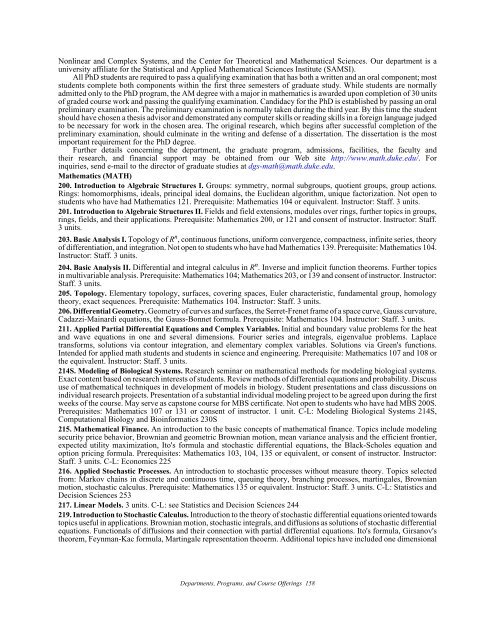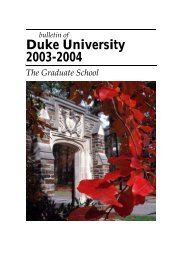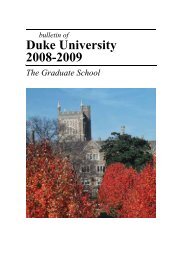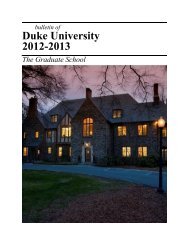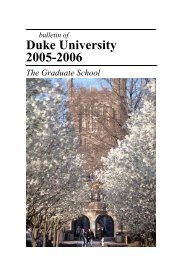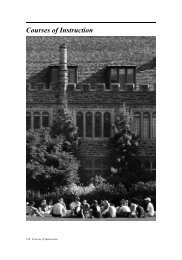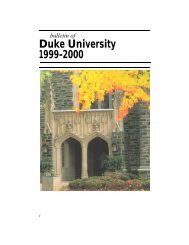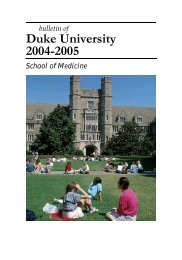Duke University 2009-2010 - Office of the Registrar - Duke University
Duke University 2009-2010 - Office of the Registrar - Duke University
Duke University 2009-2010 - Office of the Registrar - Duke University
Create successful ePaper yourself
Turn your PDF publications into a flip-book with our unique Google optimized e-Paper software.
Nonlinear and Complex Systems, and <strong>the</strong> Center for Theoretical and Ma<strong>the</strong>matical Sciences. Our department is a<br />
university affiliate for <strong>the</strong> Statistical and Applied Ma<strong>the</strong>matical Sciences Institute (SAMSI).<br />
All PhD students are required to pass a qualifying examination that has both a written and an oral component; most<br />
students complete both components within <strong>the</strong> first three semesters <strong>of</strong> graduate study. While students are normally<br />
admitted only to <strong>the</strong> PhD program, <strong>the</strong> AM degree with a major in ma<strong>the</strong>matics is awarded upon completion <strong>of</strong> 30 units<br />
<strong>of</strong> graded course work and passing <strong>the</strong> qualifying examination. Candidacy for <strong>the</strong> PhD is established by passing an oral<br />
preliminary examination. The preliminary examination is normally taken during <strong>the</strong> third year. By this time <strong>the</strong> student<br />
should have chosen a <strong>the</strong>sis advisor and demonstrated any computer skills or reading skills in a foreign language judged<br />
to be necessary for work in <strong>the</strong> chosen area. The original research, which begins after successful completion <strong>of</strong> <strong>the</strong><br />
preliminary examination, should culminate in <strong>the</strong> writing and defense <strong>of</strong> a dissertation. The dissertation is <strong>the</strong> most<br />
important requirement for <strong>the</strong> PhD degree.<br />
Fur<strong>the</strong>r details concerning <strong>the</strong> department, <strong>the</strong> graduate program, admissions, facilities, <strong>the</strong> faculty and<br />
<strong>the</strong>ir research, and financial support may be obtained from our Web site http://www.math.duke.edu/. For<br />
inquiries, send e-mail to <strong>the</strong> director <strong>of</strong> graduate studies at dgs-math@math.duke.edu.<br />
Ma<strong>the</strong>matics (MATH)<br />
200. Introduction to Algebraic Structures I. Groups: symmetry, normal subgroups, quotient groups, group actions.<br />
Rings: homomorphisms, ideals, principal ideal domains, <strong>the</strong> Euclidean algorithm, unique factorization. Not open to<br />
students who have had Ma<strong>the</strong>matics 121. Prerequisite: Ma<strong>the</strong>matics 104 or equivalent. Instructor: Staff. 3 units.<br />
201. Introduction to Algebraic Structures II. Fields and field extensions, modules over rings, fur<strong>the</strong>r topics in groups,<br />
rings, fields, and <strong>the</strong>ir applications. Prerequisite: Ma<strong>the</strong>matics 200, or 121 and consent <strong>of</strong> instructor. Instructor: Staff.<br />
3 units.<br />
203. Basic Analysis I. Topology <strong>of</strong> R n , continuous functions, uniform convergence, compactness, infinite series, <strong>the</strong>ory<br />
<strong>of</strong> differentiation, and integration. Not open to students who have had Ma<strong>the</strong>matics 139. Prerequisite: Ma<strong>the</strong>matics 104.<br />
Instructor: Staff. 3 units.<br />
204. Basic Analysis II. Differential and integral calculus in R n . Inverse and implicit function <strong>the</strong>orems. Fur<strong>the</strong>r topics<br />
in multivariable analysis. Prerequisite: Ma<strong>the</strong>matics 104; Ma<strong>the</strong>matics 203, or 139 and consent <strong>of</strong> instructor. Instructor:<br />
Staff. 3 units.<br />
205. Topology. Elementary topology, surfaces, covering spaces, Euler characteristic, fundamental group, homology<br />
<strong>the</strong>ory, exact sequences. Prerequisite: Ma<strong>the</strong>matics 104. Instructor: Staff. 3 units.<br />
206. Differential Geometry. Geometry <strong>of</strong> curves and surfaces, <strong>the</strong> Serret-Frenet frame <strong>of</strong> a space curve, Gauss curvature,<br />
Cadazzi-Mainardi equations, <strong>the</strong> Gauss-Bonnet formula. Prerequisite: Ma<strong>the</strong>matics 104. Instructor: Staff. 3 units.<br />
211. Applied Partial Differential Equations and Complex Variables. Initial and boundary value problems for <strong>the</strong> heat<br />
and wave equations in one and several dimensions. Fourier series and integrals, eigenvalue problems. Laplace<br />
transforms, solutions via contour integration, and elementary complex variables. Solutions via Green's functions.<br />
Intended for applied math students and students in science and engineering. Prerequisite: Ma<strong>the</strong>matics 107 and 108 or<br />
<strong>the</strong> equivalent. Instructor: Staff. 3 units.<br />
214S. Modeling <strong>of</strong> Biological Systems. Research seminar on ma<strong>the</strong>matical methods for modeling biological systems.<br />
Exact content based on research interests <strong>of</strong> students. Review methods <strong>of</strong> differential equations and probability. Discuss<br />
use <strong>of</strong> ma<strong>the</strong>matical techniques in development <strong>of</strong> models in biology. Student presentations and class discussions on<br />
individual research projects. Presentation <strong>of</strong> a substantial individual modeling project to be agreed upon during <strong>the</strong> first<br />
weeks <strong>of</strong> <strong>the</strong> course. May serve as capstone course for MBS certificate. Not open to students who have had MBS 200S.<br />
Prerequisites: Ma<strong>the</strong>matics 107 or 131 or consent <strong>of</strong> instructor. 1 unit. C-L: Modeling Biological Systems 214S,<br />
Computational Biology and Bioinformatics 230S<br />
215. Ma<strong>the</strong>matical Finance. An introduction to <strong>the</strong> basic concepts <strong>of</strong> ma<strong>the</strong>matical finance. Topics include modeling<br />
security price behavior, Brownian and geometric Brownian motion, mean variance analysis and <strong>the</strong> efficient frontier,<br />
expected utility maximization, Ito's formula and stochastic differential equations, <strong>the</strong> Black-Scholes equation and<br />
option pricing formula. Prerequisites: Ma<strong>the</strong>matics 103, 104, 135 or equivalent, or consent <strong>of</strong> instructor. Instructor:<br />
Staff. 3 units. C-L: Economics 225<br />
216. Applied Stochastic Processes. An introduction to stochastic processes without measure <strong>the</strong>ory. Topics selected<br />
from: Markov chains in discrete and continuous time, queuing <strong>the</strong>ory, branching processes, martingales, Brownian<br />
motion, stochastic calculus. Prerequisite: Ma<strong>the</strong>matics 135 or equivalent. Instructor: Staff. 3 units. C-L: Statistics and<br />
Decision Sciences 253<br />
217. Linear Models. 3 units. C-L: see Statistics and Decision Sciences 244<br />
219. Introduction to Stochastic Calculus. Introduction to <strong>the</strong> <strong>the</strong>ory <strong>of</strong> stochastic differential equations oriented towards<br />
topics useful in applications. Brownian motion, stochastic integrals, and diffusions as solutions <strong>of</strong> stochastic differential<br />
equations. Functionals <strong>of</strong> diffusions and <strong>the</strong>ir connection with partial differential equations. Ito's formula, Girsanov's<br />
<strong>the</strong>orem, Feynman-Kac formula, Martingale representation <strong>the</strong>oerm. Additional topics have included one dimensional<br />
Departments, Programs, and Course Offerings 158


